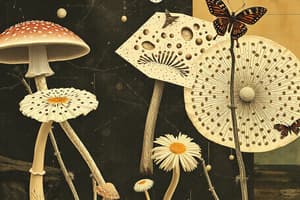Podcast
Questions and Answers
Are fungi prokaryotic or eukaryotic?
Are fungi prokaryotic or eukaryotic?
Eukaryotic cell structure
The cell walls of fungi are composed of what chemical compound?
The cell walls of fungi are composed of what chemical compound?
Chitin
What is the nutritional strategy in fungi?
What is the nutritional strategy in fungi?
Absorptive mode of nutrition
Chitin is a polymer composed of what monomer?
Chitin is a polymer composed of what monomer?
The largest part of fungi is called what?
The largest part of fungi is called what?
How would you distinguish between septate and aseptate fungi?
How would you distinguish between septate and aseptate fungi?
What is one of the oldest and largest fungal species?
What is one of the oldest and largest fungal species?
What are the ecological roles of fungi?
What are the ecological roles of fungi?
A lichen is an organism that is the symbiotic product of what 2 organisms?
A lichen is an organism that is the symbiotic product of what 2 organisms?
What are the ecological roles of lichen?
What are the ecological roles of lichen?
What is a fungivore?
What is a fungivore?
Describe the mutualistic symbiosis between leaf cutting ants and their food fungus.
Describe the mutualistic symbiosis between leaf cutting ants and their food fungus.
How do some fungi prey on nematodes?
How do some fungi prey on nematodes?
How does the fungus, Cordyceps, brainwash its host and alter the host's behavior?
How does the fungus, Cordyceps, brainwash its host and alter the host's behavior?
What fungus has led to massive mortality in amphibians?
What fungus has led to massive mortality in amphibians?
What percentage of plant diseases are caused by fungi?
What percentage of plant diseases are caused by fungi?
What beneficial fungus lives in plant tissues, and how does this fungus benefit the plant?
What beneficial fungus lives in plant tissues, and how does this fungus benefit the plant?
Distinguish between endomycorrhizae and ectomycorrhizae.
Distinguish between endomycorrhizae and ectomycorrhizae.
What are the beneficial and negative roles of fungi?
What are the beneficial and negative roles of fungi?
What are the symptoms of ergot of rye?
What are the symptoms of ergot of rye?
How did ergot influence human history?
How did ergot influence human history?
Flashcards are hidden until you start studying
Study Notes
Fungi Kingdom Overview
- Fungi belong to the Eukarya domain and exhibit a eukaryotic cell structure.
- Cell walls are composed of chitin, a polymer made from glucosamine monomers, which contain glucose and amino groups.
Nutritional Strategy
- Fungi utilize an absorptive mode of nutrition by secreting powerful enzymes that digest organic materials outside their bodies.
Structural Characteristics
- The largest part of most fungi is mycelia, which consist of invisible hyphae found in soil or organic matter.
- Fungi can be categorized based on septation: septate fungi have pores that facilitate the flow of cellular components, while aseptate (coenocytic) fungi lack septa and have a continuous cytoplasm.
Ecological Importance
- Fungi are critical decomposers, breaking down organic matter such as dead plants and animals in diverse biomes and aquatic environments.
- Lichens, symbiotic associations of fungi and algae, provide food and habitat for various organisms.
Fungal Interactions
- Fungivores are animals that feed on fungi, emphasizing their role in food chains.
- Leaf-cutting ants engage in mutualistic relationships with fungi, relying on these fungi for food while providing structural support and enhanced growth conditions through their secretions.
Parasitic Fungi
- Some fungi utilize predatory strategies, such as producing loops to ensnare nematodes for nutrients.
- Cordyceps fungi manipulate insect behaviors to facilitate their reproductive strategies.
Pathogenic Fungi
- Chytrid fungus is a significant threat to amphibian populations, contributing to global extinctions and is resilient to UV light.
- About 80% of plant diseases are caused by fungi, with the remaining 20% attributed to bacteria, viruses, and nematodes.
Beneficial Fungi
- Endophytic fungi reside within plant tissues and produce compounds to deter herbivores, while also enhancing plant resilience to environmental stresses.
- Ectomycorrhizae envelop roots with hyphal sheaths, while endomycorrhizae penetrate root cell walls without affecting the cytoplasm.
Human Relevance
- Fungi have both beneficial and harmful implications: they are sources of food, yeast for fermentation, and antibiotics but can also be parasites causing diseases (mycosis) in humans and animals.
- Ergot of rye, a fungal parasite, can cause ergotism, leading to symptoms like gangrene and hallucinations, and historical influences such as the Salem Witch Trials.
Studying That Suits You
Use AI to generate personalized quizzes and flashcards to suit your learning preferences.




